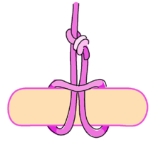
Bale sling hitch
Encyclopedia
The bale sling hitch is a knot
which traditionally uses a continuous loop of strap
to form a cow hitch
around an object in order to hoist or lower it. In practice, a similar arrangement can also be formed using a fixed loop at the end of a rope
. This loop could be formed at the end of a line with a knot, such as the bowline
, or a large eye splice
.
Knot
A knot is a method of fastening or securing linear material such as rope by tying or interweaving. It may consist of a length of one or several segments of rope, string, webbing, twine, strap, or even chain interwoven such that the line can bind to itself or to some other object—the "load"...
which traditionally uses a continuous loop of strap
Strap
A strap, sometimes also called strop, is an elongated flap or ribbon, usually of fabric or leather.Thin straps are used as part of clothing or baggage, or bedding such as a sleeping bag. See for example spaghetti strap, shoulder strap...
to form a cow hitch
Cow hitch
The cow hitch is a hitch knot used to attach a rope to an object. The cow hitch comprises a pair of half-hitches tied in opposing directions, as compared to the clove hitch in which the half-hitches are tied in the same direction. It has several variations and is known under a variety of names...
around an object in order to hoist or lower it. In practice, a similar arrangement can also be formed using a fixed loop at the end of a rope
Rope
A rope is a length of fibres, twisted or braided together to improve strength for pulling and connecting. It has tensile strength but is too flexible to provide compressive strength...
. This loop could be formed at the end of a line with a knot, such as the bowline
Bowline
The bowline is an ancient and simple knot used to form a fixed loop at the end of a rope. It has the virtues of being both easy to tie and untie. The bowline is sometimes referred as King of the knots because of its importance...
, or a large eye splice
Eye splice
The eye splice is the best method of creating a permanent loop in the end of multi stranded rope by means of rope splicing. The ends of the rope are tucked back into the standing end to form the loop. Originally this splice was described with each end being tucked only about three times. When...
.

